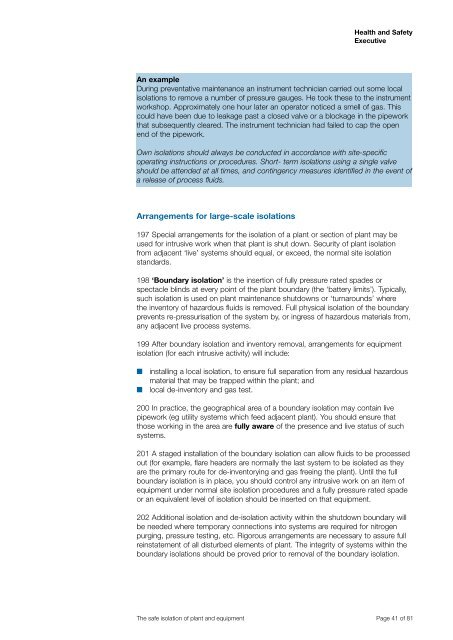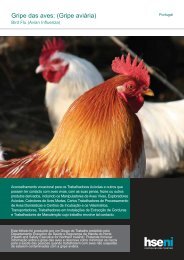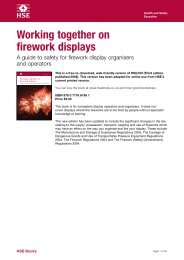The safe isolation of plant and equipment (HSG253) - Health and ...
The safe isolation of plant and equipment (HSG253) - Health and ...
The safe isolation of plant and equipment (HSG253) - Health and ...
You also want an ePaper? Increase the reach of your titles
YUMPU automatically turns print PDFs into web optimized ePapers that Google loves.
<strong>Health</strong> <strong>and</strong> Safety<br />
Executive<br />
An example<br />
During preventative maintenance an instrument technician carried out some local<br />
<strong>isolation</strong>s to remove a number <strong>of</strong> pressure gauges. He took these to the instrument<br />
workshop. Approximately one hour later an operator noticed a smell <strong>of</strong> gas. This<br />
could have been due to leakage past a closed valve or a blockage in the pipework<br />
that subsequently cleared. <strong>The</strong> instrument technician had failed to cap the open<br />
end <strong>of</strong> the pipework.<br />
Own <strong>isolation</strong>s should always be conducted in accordance with site-specific<br />
operating instructions or procedures. Short- term <strong>isolation</strong>s using a single valve<br />
should be attended at all times, <strong>and</strong> contingency measures identified in the event <strong>of</strong><br />
a release <strong>of</strong> process fluids.<br />
Arrangements for large-scale <strong>isolation</strong>s<br />
197 Special arrangements for the <strong>isolation</strong> <strong>of</strong> a <strong>plant</strong> or section <strong>of</strong> <strong>plant</strong> may be<br />
used for intrusive work when that <strong>plant</strong> is shut down. Security <strong>of</strong> <strong>plant</strong> <strong>isolation</strong><br />
from adjacent ‘live’ systems should equal, or exceed, the normal site <strong>isolation</strong><br />
st<strong>and</strong>ards.<br />
198 ‘Boundary <strong>isolation</strong>’ is the insertion <strong>of</strong> fully pressure rated spades or<br />
spectacle blinds at every point <strong>of</strong> the <strong>plant</strong> boundary (the ‘battery limits’). Typically,<br />
such <strong>isolation</strong> is used on <strong>plant</strong> maintenance shutdowns or ‘turnarounds’ where<br />
the inventory <strong>of</strong> hazardous fluids is removed. Full physical <strong>isolation</strong> <strong>of</strong> the boundary<br />
prevents re-pressurisation <strong>of</strong> the system by, or ingress <strong>of</strong> hazardous materials from,<br />
any adjacent live process systems.<br />
199 After boundary <strong>isolation</strong> <strong>and</strong> inventory removal, arrangements for <strong>equipment</strong><br />
<strong>isolation</strong> (for each intrusive activity) will include:<br />
■<br />
■<br />
installing a local <strong>isolation</strong>, to ensure full separation from any residual hazardous<br />
material that may be trapped within the <strong>plant</strong>; <strong>and</strong><br />
local de-inventory <strong>and</strong> gas test.<br />
200 In practice, the geographical area <strong>of</strong> a boundary <strong>isolation</strong> may contain live<br />
pipework (eg utility systems which feed adjacent <strong>plant</strong>). You should ensure that<br />
those working in the area are fully aware <strong>of</strong> the presence <strong>and</strong> live status <strong>of</strong> such<br />
systems.<br />
201 A staged installation <strong>of</strong> the boundary <strong>isolation</strong> can allow fluids to be processed<br />
out (for example, flare headers are normally the last system to be isolated as they<br />
are the primary route for de-inventorying <strong>and</strong> gas freeing the <strong>plant</strong>). Until the full<br />
boundary <strong>isolation</strong> is in place, you should control any intrusive work on an item <strong>of</strong><br />
<strong>equipment</strong> under normal site <strong>isolation</strong> procedures <strong>and</strong> a fully pressure rated spade<br />
or an equivalent level <strong>of</strong> <strong>isolation</strong> should be inserted on that <strong>equipment</strong>.<br />
202 Additional <strong>isolation</strong> <strong>and</strong> de-<strong>isolation</strong> activity within the shutdown boundary will<br />
be needed where temporary connections into systems are required for nitrogen<br />
purging, pressure testing, etc. Rigorous arrangements are necessary to assure full<br />
reinstatement <strong>of</strong> all disturbed elements <strong>of</strong> <strong>plant</strong>. <strong>The</strong> integrity <strong>of</strong> systems within the<br />
boundary <strong>isolation</strong>s should be proved prior to removal <strong>of</strong> the boundary <strong>isolation</strong>.<br />
<strong>The</strong> <strong>safe</strong> <strong>isolation</strong> <strong>of</strong> <strong>plant</strong> <strong>and</strong> <strong>equipment</strong> Page 41 <strong>of</strong> 81







